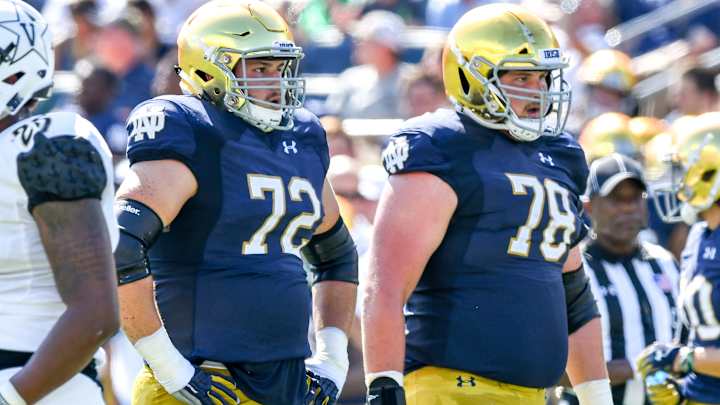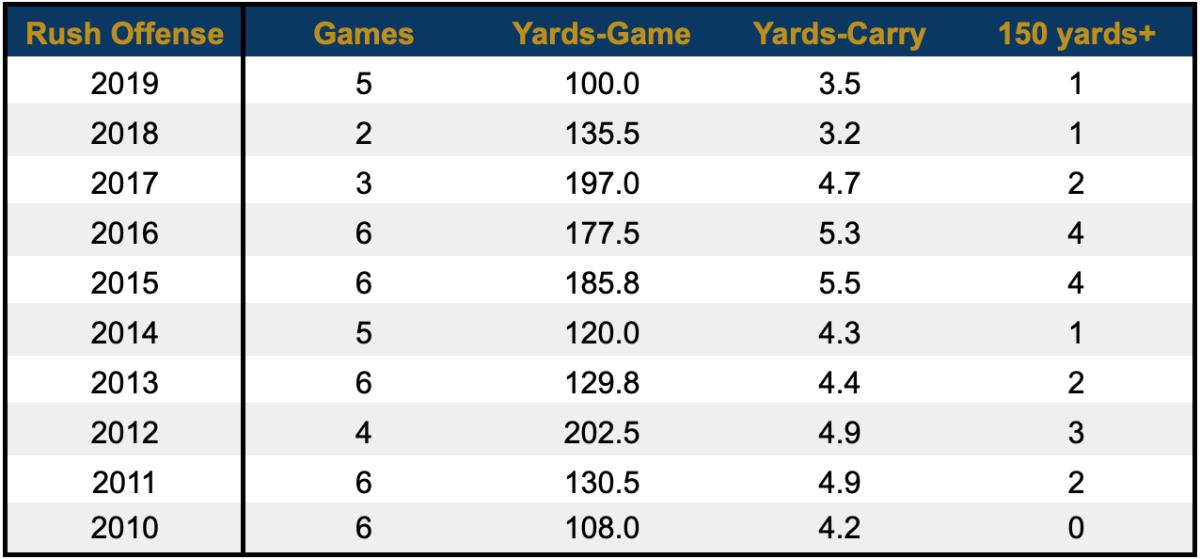Notre Dame Run Game Must Make Dramatic Improvement

Following Notre Dame’s victory over Stanford, head coach Brian Kelly made an interesting comment about his offense.
When asked about his offensive identity, Kelly responded with this:
“I think it is what it is. We have the ability to run the football when needed. As you saw today, we rushed for close to 200 yards when we needed to.”
When I heard Coach Kelly make that comment the first thought that ran through my head was this is exactly why Notre Dame continues to fall behind other title contenders on offense.
With one exception (2015), Notre Dame has failed to put a championship caliber offense on the field during Kelly's tenure. The closest it came after that was 2017, but late-season quarterback issues dragged down that unit. But this is why Notre Dame’s offense continues to come up small in the team’s biggest games.
Not being able to consistently score against the better teams on the schedule has been a road block for this program for the last decade, and we saw that again this fall. Against the four ranked Power 5 opponents that Notre Dame faced this season, the offense averaged just 22.3 points per game, 324.0 yards per game and 4.93 yards per play. The Irish averaged just 126.8 rushing yards in those four games.
Underwhelming offensive line play has resulted in an underachieving run game, which has been a driving force behind this year’s struggles. When the offense failed to run the ball effectively a season ago, Kelly focused on the inexperience of the unit, the loss of two first-round draft picks and the injury to Alex Bars. But Notre Dame returned four starting offensive linemen in 2019, and it is a talented unit, so I'm struggling to find a justifiable excuse for the woes this fall.
Notre Dame certainly can't point to a lack of talent up front, but the unit largely underachieved this season. According to Pro Football Focus, left tackle Liam Eichenberg is the only returning starter (among four) that improved his run blocking grade from last season. That's a troubling sign of regression.
The two best teams Notre Dame faced this year were Georgia and Michigan, and both games were on the road. In those two contests, Notre Dame rushed for just 103 combined yards and averaged just 2.5 yards per rush (sacks and team runs were removed).
Those games certainly seemed like moments where the run game was needed, and it didn’t show up in either game. Notre Dame didn’t even try to run the ball against Georgia, with the Irish backs carrying the ball just nine times. Notre Dame either had a lead, was tied, or was within one score for 50 minutes of game action against the Bulldogs, but apparently Notre Dame didn’t “need” to run the ball during the game.
It was a game where Notre Dame needed to run the ball but couldn't.
Michigan was another. There was a rain storm that night, which would seem like a great time to run the ball, but Notre Dame averaged just 2.0 yards per rush in the contest. Another big game, another time where the run game was needed, and another game where Notre Dame failed to run the football.
Not being able to run the ball effectively against top opponents, and top run defenses, has been a common theme for the Irish the last two seasons. Notre Dame faced five Top 40 run defenses this season, and in those contests the Irish averaged just 100.0 yards per game and 3.5 yards per carry, with sacks and team runs removed from the numbers.
The Irish averaged 135.5 rush yards and only 3.2 yards per carry against two Top 40 run defenses last fall. The last two seasons are the worst during the Kelly tenure from a yards per carry standpoint, and the 2019 season was the worst of the Kelly era from a yards per game standpoint. The only season that was close was Kelly’s first season.

That level of production is unacceptable for an offense that can put the talent on the field that Notre Dame can. Notre Dame had the size, talent and experience to be a really good line this season, but from the beginning of the season the unit was far too erratic. It had some bright moments (USC, Duke), but for the most part it relied on being talented, with technique often lacking.
It is also a far cry from where the unit was the previous two seasons. In 2016-17, Notre Dame averaged 184.0 rushing yards per game and 5.1 yards per rush against Top 40 run defenses.
There were far too many excuses made for the lack of production from the line the last two seasons. Inexperience is a poor excuse, as is using injuries. The 2019 line underachieved long before Tommy Kraemer and Robert Hainsey went down with injuries.
Oklahoma lost four starting offensive linemen from last season, and all four were drafted between the 2nd and 4th rounds of the 2019 NFL Draft. Yet Oklahoma was still able to manage 260.0 rushing yards and 6.4 yards per rush this season. Even if you take out the 1,217 yards that quarterback Jalen Hurts generated, Oklahoma still averaged 170.5 rushing yards per game (sacks, team runs removed). Notre Dame’s entire offense averaged just 184.6 rushing yards per game, with four returning starters.
Notre Dame lacks the talent at running back of other top teams, but the backfield is good enough for the run game to have been much better than it was this season. The inability to run the ball against the better defenses places the offense well behind other top programs that are competing for championships.

This graph breaks down how Notre Dame and other top teams fare in the run game against Top 50 run defenses. As you can see, Notre Dame is way behind other top offenses.
While its admirable that Notre Dame’s offensive line protected relatively well in the pass game this season, good coaches get their lines to play well in both areas. Notre Dame’s run game struggles this season weren’t about talent, they were about a line that doesn’t play with the necessary force or technique needed.
Far too often the Irish line looked unprepared to handle the line games that defenses were throwing at the unit, and rarely were they able to adjust on the fly. Instead of using their size and talent to their advantage, far too frequently the line caught defenders instead of coming off the ball with force. Combo blocks often struggled to get to the second level in those games, another technique issue.
There were flashes of this unit playing to its potential, but those instances were far too infrequent, and usually against inferior opponents. Notre Dame averaged 267.0 rushing yards and 6.4 yards per carry in five games against opponents that ranked No. 75 or higher in run defense.
Offensive coordinator Chip Long had to rely on using creativity and gimmick plays to generate runs instead of being able to rely on running behind his talented line. Notre Dame had 242 rushing yards from its wide receivers, and sophomore wide receiver Braden Lenzy had the two longest runs of the season. On neither play was the line a factor in the success of the play.
A good chunk of Notre Dame’s rushing yards also came from quarterback scrambles in the pass game. Against Stanford, for example, Notre Dame converted a 4th-and-2 on a 26-yard quarterback scramble on a called pass play.
There was a lot of smoke and mirrors to the run game success this season, and those types of runs rarely work against better run defenses, which explains why the offense failed to move the ball on the ground against the better teams on the schedule.
Last season, Notre Dame had to rely on big plays in the run game, which is why the unit was so inefficient.
Simply put, Notre Dame’s run game needs to get a lot better. For that to happen, the play of the offensive line must get a lot better. For that to happen, the unit must be coached much better than it has the last two seasons. Until changes are made, changes beyond just "coaching a little better" or "playing a little harder," the Irish will continue to fall short of how good it should be on offense.
Notre Dame will return all five starting linemen in 2020, and it will have plenty of skill talent coming back, even if quarterback Ian Book and tight end Cole Kmet leave for the NFL. If the line plays to its potential the 2020 offense could be elite, but if the line doesn't play to its potential the Irish will once again fall short of the standard.
Follow me on Twitter: @CoachD178
Visit our Facebook page at: https://www.facebook.com/IrishMaven/
